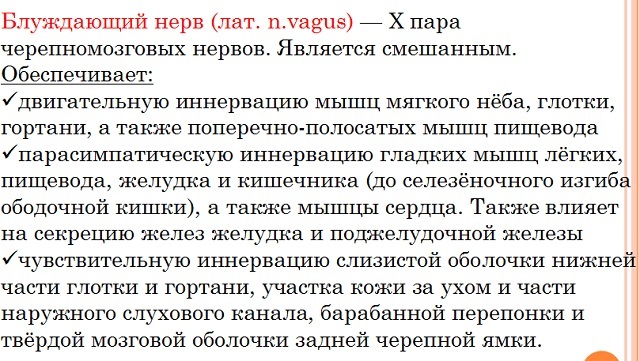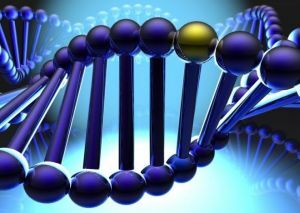 Agnosia is an unresolved neurological disease, manifested in disorders of various perceptions in the patient, but consciousness and sensitivity are preserved.
Agnosia is an unresolved neurological disease, manifested in disorders of various perceptions in the patient, but consciousness and sensitivity are preserved.
With this deviation, it is difficult for a patient to adapt to the world around him. Pathology arises from the damage to the brain structures in certain areas.
There are three main types of agnosia and many subspecies, depending on which the treatment will be adjusted. If you do not do timely therapy, then this disease can lead to certain serious violations. It should be borne in mind that agnosia is given to prevention.
Contents
- Description of the state
- Description of the state
- Basic provoking factors
- Classification of impaired perception
- Visible agnosia
- Auditory agnosia
- Disorders of tactile and spatial sensations
- What is typical for a person in this state?
- Diagnosis
- Correction of the patient's condition
- Preventive measures
Description of the condition
Agnosia is a disorder of various types of perception that occurs against the background of undisturbed consciousness and sensitivity. With this pathology, the patient ceases to recognize the stimuli, recognize the objects and begins to react incorrectly to the received signals from the outside.
There may be disturbances in behavior and condition. When the first signs of abnormalities are present, it is necessary to immediately go through the examination and start treatment. Do not engage in self-management disorders, as this can only worsen the patient's condition and provoke complications.

Major triggers of
Agnosia occurs due to damage to the cerebral cortex and a number of underlying subcortical brain areas. This deviation may be due to the following reasons:
- a variety of head injuries;

- cerebrovascular disease( stroke, atherosclerosis);
- multiple sclerosis;
- mental illness;
- a lesion of the spinal cord and brain in a child that originated in the period of gestation or during childbirth;
- neoplasms in the brain;
- degeneration of the brain regions, which are responsible for the analysis and study of information.
Classification of impaired perception
Depending on the location, the types of agnosias differ.
Agnosia is of three main types, each of which in turn is divided into subspecies.
Spotting agnosia
With this type of disorder, brain damage is localized in the occipital region. With visual agnosia, the patient can not recognize the subject or picture. The patient does not have a visual impairment.
Agnosia of this species is manifested in different ways:
- Item .When the surface of the brain is damaged, which adheres to the left part of the occipital bone: the unrecognizability of objects( the patient describes it in general terms).
- Color .With lesions of the nape of the neck of the left hemisphere, which is considered dominant: the patient is difficult to distinguish between color and shades, can not match the object and color.
- Visual, manifested in optical weakness ( optically spatial).When the occipital and parietal region is affected from two sides: the patient can not present the object and describe it.
- Facial perception disorder .With lesions of the lower region of the occiput of the right hemisphere: the patient can not recognize faces, even his own reflection, but distinguishes objects and pictures.
- Simultaneous .With lesions of the anterior part of the dominant occipital lobe: the patient can not simultaneously perceive several objects. Autopagnosia is characterized by the inability to recognize your body.
- Syndrome Balint .It is noted with a bilateral defeat of the occipital parietal region: the patient can not look in the right direction, focus the eye, can not normally read.
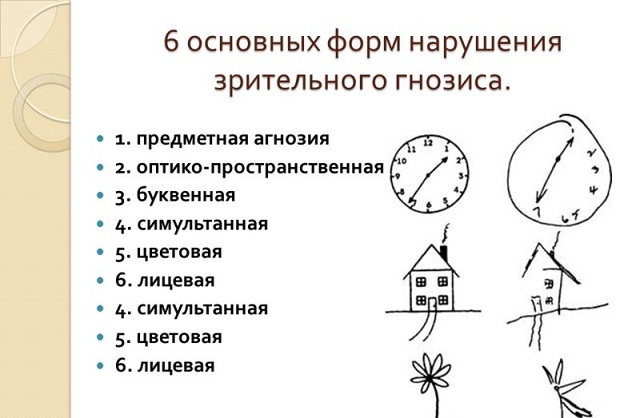
Auditory agnosia
 This type of disturbance causes damage to the cortex in the temporal region of the right hemisphere.
This type of disturbance causes damage to the cortex in the temporal region of the right hemisphere.
A patient with auditory agnosia can not recognize speech, sounds, but the auditory analyzer is not diagnosed.
This type of pathology has such disturbances that characterize each subspecies of auditory agnosia, as:
- Simple .The patient does not recognize simple sounds.
- Hearing Care .The patient is not able to distinguish between speech.
- Tone .The patient does not catch the tone, timbre, emotionality, but at the same time normally perceives phrases and words.
Disorders of tactile and spatial sensations
Tactile agnosia is characterized by the fact that the patient can not recognize the object to the touch. It happens that the patient does not even know how to recognize part of his body and evaluate its location( somatoagnosis).With asteregnosis, the patient can not recognize the object with the help of touch.
Spatial agnosia: 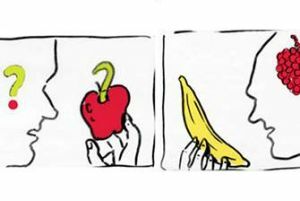
- left cerebral hemisphere lesion : impaired spatial vision( opto-spatial), in this case often intersects with visual agnosia;
- affection of the middle part of the parietal and occipital region : the patient can not localize the object in space.
There is also a spatial neurological disorder:
- which is expressed in violation of one of the half of the space;
- which is expressed in violation of topographic orientation.
What is typical for a person in this condition?
This neurologic disease can be diagnosed only by a specialist on the basis of the following symptoms:
- disturbed landmark, the patient does not understand the map;
- the patient denies that he has abnormalities and defects, although there is a violation;
- patient is not interested in the defect;
- the patient ceases to recognize objects to the touch, sounds;
- the patient does not perceive his body;
- violated the ability to recognize faces, even close people;
- the patient is not able to recognize complex images, also ignores much of what is seen in space.
Diagnosis of
This neurological disorder is not a common disease. Most often diagnosed at the age of 18 years.
Occurs as a result of many provoking factors that affect each patient in different ways. In most cases, to diagnose it is necessary to conduct a comprehensive neurological examination.
Diagnostics uses such research methods:
- magnetic resonance tomography;
- computed tomography;
- neuropsychological and physical examinations.
It is necessary to pay attention to the symptoms and complaints, how long they appeared, and what could provoke them. The specialist asks the patient to identify the items using different feelings.
Neurologic examination is as follows: 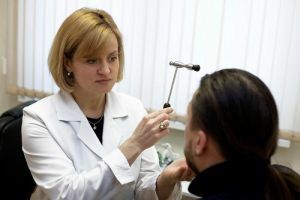
- assessment of mental functions;
- assessment of visual functions;
- evaluation of auditory functions.
Neuropsychological examination is as follows: assessment of the patient's condition using questionnaires, interviews. If necessary, the patient is referred for consultation to a psychiatrist.
Correction of the patient's condition
Treatment is appointed by a specialist after a thorough examination and based on the results obtained. Independent therapy in this situation is not effective and contraindicated, can lead to irreversible consequences of brain damage.
To eliminate the disease, it is necessary to eliminate the underlying pathology that triggered this deviation.
In most cases, treatment lasts no more than three months - enough time to recover. But there are exceptions, when the therapy is carried out for six months - a year. The positive result depends on the age group of the patient, the severity and nature of the lesion.
After provoking causal has been eliminated it is necessary to make some adjustments that are aimed at eliminating the disease and the disturbed state of the body. Therefore, experts recommend:
- to attend speech therapy sessions;
- psychotherapeutic sessions;
- deal with educators;
- to devote more time to occupational therapy.
When agnosia is recommended to constantly monitor blood pressure, if necessary, take drugs that improve  blood flow and brain nutrition( nootropics and antiaggregants).
blood flow and brain nutrition( nootropics and antiaggregants).
If a patient has been diagnosed with a brain tumor, then surgical intervention to remove the neoplasm is mandatory.
To improve the neuropsychological function prescribe anticholinesterase drugs. Parallel sessions are conducted with a neuropsychologist.
Preventive measures
Special preventive methods do not exist, but experts recommend following such advice:
- a correct and healthy lifestyle;
- refusal from alcohol and tobacco smoking;
- observance of a mode of rest and work;
- correct and balanced nutrition;
- timely diagnosis and treatment of provoking diseases;
- control of blood pressure.

Agnosia, although a rare disease, but can lead to irreversible effects, so it is worth paying attention to health and abnormalities. It's impossible to diagnose yourself, so do not ignore professional help. With the right approach, you can get rid of rejection in the shortest possible time.


